
Tokyu Fudosan Holdings Group's business activities rely heavily on ecosystem services for land development and materials procurement. Given this, we are strongly aware that biodiversity conservation represents an important environmental issue.
The loss of biodiversity would make it difficult for us to reap the benefits of ecosystem services that until now have benefited our businesses in terms of land use and construction materials procurement, which carries with it the risk of much higher costs. Furthermore, the loss of biodiversity is an extremely critical issue that could threaten the very existence of society and human life.
The development and operation of housing, office buildings, commercial facilities and resorts that help to conserve biodiversity will create business opportunities and enhance the competitiveness of the Group. At Tokyo Port City Takeshiba, the largest office building in which Tokyu Land Corporation is involved, we are working on biodiversity conservation as Takeshiba Shinpachikei.
Our group respects the international goal of becoming "nature positive'' as set out in the "Kunming Montreal Biodiversity Framework (GBF),'' and works with stakeholders such as business partners, customers, and local communities to improve biodiversity. We will promote initiatives to avoid and minimize negative impacts on diversity and expand positive impacts.

The Group has established the Sustainability Committee headed by the President & Representative Director, and to address climate change issues, the Sustainability Council, established as a subcommittee, leads relevant management activities across the entire Group.
The Sustainability Council, comprised of environmental and sustainability managers from each group company, manages the results of group-wide efforts on biodiversity issues and shares information based on a shared policy. This ensures biodiversity conservation is addressed throughout all business activities.
We believe that urban greening is important for addressing biodiversity issues. Therefore, in the wide-area Shibuya area, which the Group has designated as a priority development area, we are actively greening our business bases in order to conserve the ecosystem. We are working to form an ecological network in the wide-area Shibuya area by connecting the surrounding greenery and acting as a relay base for the creatures that live there.
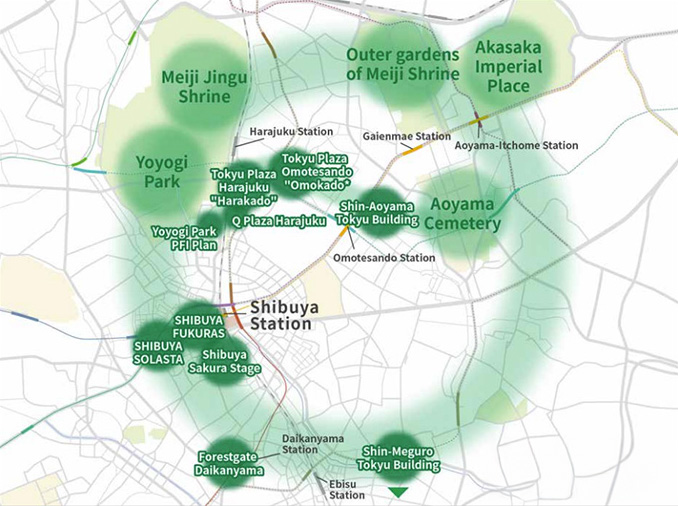
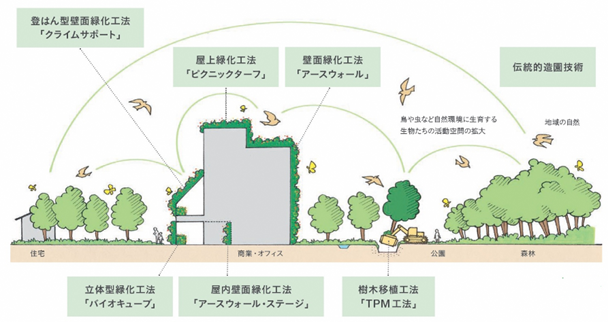
Tokyu Land Holdings Group will conserve 40% of the land and sea area in its wellness business areas, including hotels and resorts and healthcare business, in order to achieve the goal of halting and restoring biodiversity loss by 2030 (Nature Positive), exceeding the 30by30 target of effectively conserving at least 30% of the land and sea as healthy ecosystems by 2030. The "conserved" area refers to (1) the area of land subject to OECM certification and other environmental certifications for biodiversity and green space conservation systems, (2) the area falling within the area of national parks, national parks, and natural parks, and (3) forests subject to the preparation of forest management plans under the Forest Law.
The Group formulates a Biodiversity Action Plan (BAP) by identifying areas in all of our business regions that have sites, species, and functions of particular importance for conservation. In the relevant areas, biodiversity monitoring by experts is conducted on a regular basis, and the results are reflected in the management plan in an effort to conserve biodiversity.
Resort Town Tateshina plans to establish a monitoring plan to survey the habitat and growth environment of plants and animals in the villa area and surrounding wooded areas, etc., and if there are any rare plant or animal species or threats to the habitat or growth environment, countermeasures will be considered and utilized in the green space management plan.

(Non-native flora) Annual fleabane
According to the Invasive Alien Species Act (Ministry of the Environment), an invasive alien species is a species of fauna or flora that did not originally reside in Japan and was brought to Japan intentionally or unintentionally by human actions and that may cause damages to local ecosystems. The Group has created a manual that outlines ways to deal with an invasive alien species if it is found in order to protect the community's ecosystem.
 (Non-native fauna)
(Non-native fauna) (Non-native flora)
(Non-native flora)
Ecosystem study in progress at Tokyu Plaza Omotesando Harajuku
《New project》The Group is actively greening condominiums, office buildings, commercial facilities, and other buildings to connect the surrounding greenery and preserve local biodiversity by working to create an ecological network that takes biodiversity into consideration.
《Existing project》For example, at the roof terrace garden named Omohara Forest at Tokyu Plaza Omotesando Harajuku, we conduct regular studies on living organisms throughout the year with Regional Environmental Planning, Inc., a specialist in natural environment conservation in order to gain an understanding of the ecosystem created there,.
 Ecosystem study in progress
Ecosystem study in progress Seven-spot ladybug
Seven-spot ladybug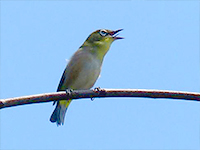 Japanese white-eye
Japanese white-eyeAt "Tokyo Port City Takeshiba Office Tower", we are working on environmental education and reduction of environmental load through contact with living things and farming experience. We will improve people's awareness and understanding of biodiversity by developing the "Takeshiba Shinhakkei", which consists of eight views of "rain, water, islands, paddy fields, incense, vegetable gardens, bees, and the sky." In addition, in order to contribute to the creation of a habitat for birds of prey such as peregrine falcons, we have set up nest boxes for nesting and are working to maintain and improve biodiversity and ecosystems.
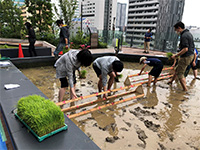 Rice planting
Rice planting Pre-harvest strawberries
Pre-harvest strawberries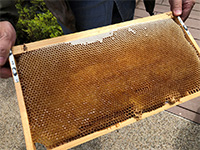 Bee hive
Bee hive“Tambara Ski Park" has been working to protect ‘forest green tree frogs’, which are registered as near-threatened and mild concerns on the Red List of Gunma Prefecture and the International Union for Conservation of Nature IUCN.
“Tambara Ski Park" has been working to protect ‘forest green tree frogs’, which are registered as near-threatened and mild concerns on the Red List of Gunma Prefecture and the International Union for Conservation of Nature IUCN. During development, we preserved the pond inhabited to protect the forest green tree frogs. After that, every year, we carry out conservation activities in collaboration with local volunteer groups (Nature Lovers Association), such as cleaning the pond and replenishing water in the summer when the water level drops.
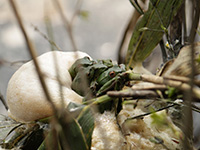 Newborn forest green frogs
Newborn forest green frogs Swimming forest green frog
Swimming forest green frog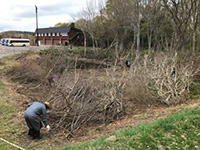 Cleaning the pond
Cleaning the pondThe coast in front of the resort hotel "Palau Pacific Resort" in the Republic of Palau was a sea where coral did not easily inhabit due to the outflow of mud. Did. In 2002, the sea across the hotel was designated as a marine life reserve by state ordinance and is now a great snorkeling area where you can see many species of fish and corals. In April 2010, we transplanted 30 giant clams to the beach of the hotel with more than 30 guests. We are also co-sponsoring the holding of an educational event "Dugong Week" for all elementary and junior high school students in Palau to protect the endangered dugong that lives in the waters near Palau.
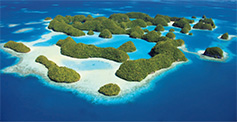 Seventy Island in Palau, designated as a Wildlife Sanctuary
Seventy Island in Palau, designated as a Wildlife Sanctuary "Dugong" inhabiting the Palauan waters
"Dugong" inhabiting the Palauan waters30 by 30 (30 by 30) refers to the goal of halting and restoring biodiversity loss (nature positive) by 2030, as promised at the G7 Summit held in England in June 2021. The goal is to effectively conserve at least 30% of land and sea as healthy ecosystems by 2030. Tokyu Fudosan Holdings Co., Ltd. and Tokyu Resorts & Stays Co., Ltd. support this purpose and participate in the 30by30 Alliance. For example, Tokyu Resort Town Tateshina has created a forest management plan for its vast 660ha forest, and has been thinning it for conservation since 2018.
Tokyu Fudosan Holdings Corporation became a member of the Association for the Promotion of Businesses for Coexistence with Living Creatures (ABINC) in December 2024, and is actively involved in activities such as participating in committees. In particular, for properties with abundant natural environments in the surrounding area and the possibility of securing a large amount of green space on the premises, as well as office, commercial, hotel and resort facilities, we encourage properties to obtain ABINC certification in order to support the preservation of biodiversity, and we will continue to systematically expand our bases in the future.

FUTAKO TAMAGAWA Rise
The FUTAKO TAMAGAWA Rise integrated commercial and residential complex that is a joint venture between Tokyu Land Corporation and Tokyu Corporation acquired the top rank (AAA) for JHEP Certification, which is Ecosystem Conservation Society - Japan's system for certification of biodiversity assessments. We developed the building's roof garden into an open space containing water and greenery as a large-scale roof garden with features such as a vegetable garden and a killifish pond in an aim to create a community that is in harmony with the abundant natural environment in the surroundings.
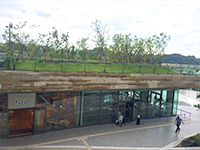 FUTAKO TAMAGAWA Rise
FUTAKO TAMAGAWA Rise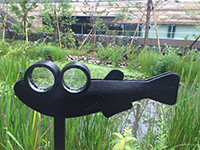 Killifish pond created
Killifish pond created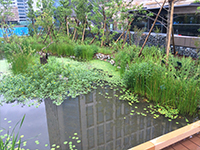
Tokyu Fudosan Holdings is participating in the 30 by 30 initiative organized by the Ministry of Environment to achieve the goal of halting and restoring biodiversity loss by 2030 (Nature Positive) and to achieve the conservation and protection of at least 30% of our terrestrial and marine areas by 2030.
Tokyu Fudosan Holdings is a member of the Keidanren Nature Conservation Council and aims to realize a sustainable society through the construction of a society that coexists with nature through exchanges with local companies and NPOs. In February 2022, the Nature Conservation Council held an online dialogue with the Mangrove Tree Planting Operation Liaison Council in the "Large-scale Mangrove Tree Planting Project in Sabua Tasara District, Nakhon Si Thammarat Province, Thailand".
In November 2024, we held a dialogue with World Wide Fund for Nature Japan (WWF Japan) on forest conservation in the revision of our sustainable procurement policy.
We received opinions on the Group's environmental initiatives and received advice on our future promotion activities in sustainable procurement. We also shared information on our approach to sustainable timber procurement.
Dialogues conducted to mitigate biodiversity loss Tokyu Resort Town Tateshina is an integrated resort developed by concluding a nature conservation agreement with Nagano Prefecture. Currently, we have concluded a comprehensive cooperation agreement with local governments, etc., and are strengthening our efforts for biodiversity by introducing biomass boilers using thinned wood generated in forest conservation.
Environment approved by the board of directors, Named position responsible ...
Goals, Initiatives, and Achievements Quantified CO₂ reduction targets ...
Targets in the investment process ① Electrical facility: Introdu...
Company position on public policy for mitigating climate change Tokyu La...
Support for mitigating climate change through Membership of business associ...
Efforts, Supports and Involvement for activities to avoid climate change ...
Tokyu Land Corporation implements the following management process as a cou...
Tokyu Fudosan Holdings measures the energy efficiency of all real estate pr...
In office buildings and commercial facilities operated and managed by Tokyu...
The Group works to reduce CO2 emissions in the office buildings it manages ...
The 356-unit Branz City Shinagawa Katsushima is a large condominium buildin...
Initiatives towards ZEB and ZEH TOKYU COMMUNITY Technology Training Cent...
Program to promote corporate value improvement through decarbon management ...
Third-party Independent Verification The Tokyu Fudosan Holdings Group rece...
Tokyu Fudosan Holdings Corporation has formulated the "TCFD/TNFD Report," w...
INTRODUCTION Introduction -Nature Positive as a Global Goal- Global env...
Risk and impact management Climate Nature ...
Metrics and targets Climate Metrics / targets ...
Transition plan for a decarbonized society Climate ...
Climate- and nature-related initiatives Examples of climate-related init...
Reference materials, terms, and explanations Appendix: Architecture of t...
Tokyu Fudosan Holdings Group makes a commitment to environmental issues an ...
Governance Sustainability Committee to assess and manage climate-related...
Strategy Faced with mounting threats of climate change and environmental...
Risk management Identifying / assessing climate-related risks/opportunit...
Metrics and targets Climate change-related targets in our long-term GROU...
Tokyu Fudosan Holdings Group makes a commitment to environmental issues an ...
Planning and management at the project site Biodiversity Action Plan (BA...
Creation of “Invasive Alien Species Response Manual” According to the In...
Biodiversity risk assessment(Disclosure of biodiversity habitat) ~ Conducti...
《Existing project》For example, at the roof terrace garden named Omohara For...
At "Tokyo Port City Takeshiba Office Tower", we are working on environmenta...
“Tambara Ski Park" has been working to protect ‘forest green tree frogs’, w...
Participation in biodiversity certification systems Systematic applicati...
Obtained the highest rank (AAA) of "JHEP Certification The FUTAKO TAMAGA...
Disclosure of engagement on efforts to reduce loss of biodiversity Gover...
The Tokyu Fudosan Holdings Group has established environmental management a...
INTRODUCTION Introduction -Nature Positive as a Global Goal- Am...
Nature-Related Information Disclosure in line with TNFD G...
Risk and impact management Risk and impact management ...
Metrics and Targets P Metrics and Targets ...
Goals, Initiatives, and Achievements Process targets to reduce or avoid ...
Tokyu Land Corporation has rigorous performance standards for its newly bui...
The Group's office buildings, commercial facilities and resorts manage and ...
Measurement of NOx, SOx, emissions According to the Air Pollution Contro...
Management Structure The Group has established the Sustainability Commit...
Process targets to reduce or avoid waste: Tokyu Land Corporation has set...
The Tokyu Fudosan Holdings Group is working to reduce waste through home re...
Ratio of establishments receiving environmental management certification ...
Working with others to reduce waste or resource use by Participation in spe...
Use of LCA (Life Cycle Analysis) The Tokyu Fudosan Holdings is developin...
Management Structure The Group has established the Sustainability Commit...
Progress against previously set targets to reduce resource use: Quantifi...
Forming a reuse cycle for wood resources The Green Connection Project is...
The Tokyu Fudosan Holdings Group has invested in a company that promotes th...
Management Structure The Group has established the Sustainability Committe...
Water conservation measures Water management plan Tokyu Land Corporat...
Reducing water use with water saving systems and features The Tokyu ...
Initiatives Along the Tama River - Environmental Conservation of the River ...
Initiatives in water-scarce regions Engagement, water withdrawal, etc. ...
Business activities in water-scarce regions The Republic of Palau is chr...
Works with others Works with others to reduce water use Tokyu Fudosan...
Collaboration with other companies operating at same sites such as making u...
Costs associated with water-related risks The cost of water-related risk...
The number of incidents of non-compliance with water quality/quantity permi...
Third-party Independent Verification The Tokyu Fudosan Holdings Group rece...
Goals, Initiatives, and Achievements Results on goals of acquisition of en...
Targets and performance on water usage from property portfolio Water Use...
Training and providing programs to raise employees' environmental awareness...
Environmental policies integrated with suppliers through Training of releva...
Tokyu Fudosan Holdings has introduced a green lease clause in some of the l...
Operating energy management systems together with tenants Tokyu Land Cor...
Tokyu Fudosan Hodings participate in the Environmental Management Committee...
Commitment to Green Field Development Commitment to Green Field Developm...
Measures to reduce energy and water consumption Aggregate energy data at...
Tokyu Community Corporation has been selected to be an MEMS aggregator as a...
Reducing water use with water saving systems and features The Tokyu ...
Reduction of water usage by using rainwater The office building "Kasumig...
As a member of the Keidanren Nature Conservation Council, Initiatives fo...
Tokyu Fudosan Holdings distributes the Sustainable Procurement Policy to it...
No-Deforestation Commitment Much of plywood used for concrete formwork i...